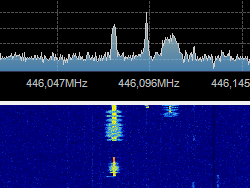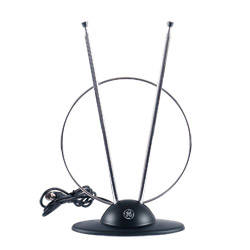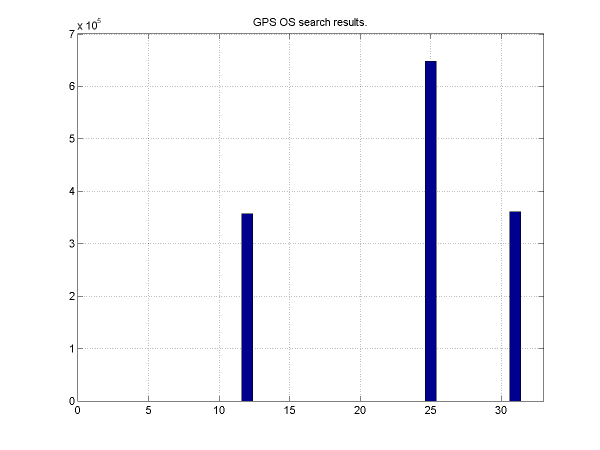USB TV tuners on rtl2832 - or how to hear everything on the radio for 600 rubles
 For a long time I was going to buy some kind of universal radio receiver / radio scanner to climb on the air, to listen to what old and bearded radio fans say at night ...
For a long time I was going to buy some kind of universal radio receiver / radio scanner to climb on the air, to listen to what old and bearded radio fans say at night ...Until recently, this pleasure cost from $ 300 to infinity. Well, with the transition of state bodies (both in Russia and abroad) to digital (but not yet encrypted) communication of the APCO P25, the cost of satisfying unhealthy curiosity has become even higher.
A year ago, everything changed - the craftsmen found out that many of the Chinese USB TV tuners we sell for 600 rubles - in fact, are a universal radio receiver that you can listen to almost anything in the range of 50-900 MHz without any modifications (if you are lucky - up to 2200 MHz, but they don’t transmit anything in particular): negotiations of airplanes with dispatchers, builders, taxis, bugs in your apartment and much more.
')
Under the cut, I'll tell you what and where to buy, how to connect and configure, and finally, what to listen to.
Iron
The USB TV tuner consists of two parts - the radio frequency part (determines the possible operating frequencies) and the digital part (digitizes the signal and transfers it to the computer via USB).
The digital part is supported by one - RTL2832.
There are several variants of the analog part: Elonics e4000 (universal favorite, works in the range of 50-1100Mhz and 1250-2200Mhz), FC0013 (~ 45-900Mhz). FC0012 is worse. It has problems with signal quality and many frequencies where it does not work.
Thus, it is better to search for receivers with e4000 or FC0013. Unfortunately, the Elonics have gone bankrupt at the moment, and recent stocks are quickly running out.
From trusted sources I can point out Dealextreme - they have run out of e4000 receivers, and now they go to FC0013. A complete list of online stores is collected here , well, and in general there is a lot of information on http://www.reddit.com/r/RTLSDR/ . In the case of a purchase on ebay / aliexpress, it is imperative that the seller clarify on which chips their tuner is made (since they very often end with them and they send others): “Hi, could you confirm that you have rtl2832 & FC0013 (e4000 ) chips? ”, then if they send you the wrong thing, it will be easier to get the money back.
Inside the receiver looks like this:

On many models, the protective diode is “forgotten” (it protects the receiver from static electricity) - you can leave it as it is, but try not to touch the antenna, and turn off the antenna from the receiver in a thunderstorm. But of course you can also solder yourself: BAV99 or, as in my case, 2 separate 1N4148 (one from the ground to the antenna, the other in the opposite direction. You just need a “fast” diode with a small capacity, which one doesn’t fit).
Antenna
A non-directional MW-UHF television antenna (“horns”) is quite suitable. I generally took on a half-meter metal pin. All this needs to be pulled out on a balcony / in a window. If the computer is far away, it is better to extend the USB cable, not the antenna. Well, it is better to remove the sources of radio frequency noise away (for example, the same computer with an open case hinders much).

Soft
A whole bunch of software options, I’ll consider a popular and fairly convenient option - SDR # under Windows (you can also read in English here ):
1) Download the latest version of SDR # Dev and SDR # RTLSDR Plugin here , and the RTLSDR library .
2) Unpack in one directory SDR # Dev and SDR # RTLSDR Plugin. From the RTLSDR library in the same directory we put the rtlsdr.dll file (it is in the archive in the x32 directory). From the subdirectory of the config file, the SDRSharp.exe.config is moved to a higher level (where the bulk of the files turned out).
3) Download Zadig - the program in order to replace the tuner driver, which can only show the TV - universal driver. We unpack in the same heap.
4) Run Zadig.exe, click Options-> List all devices, select Builk-in, Interface 0, select the driver to replace - “WinUSB”, click Reinstall Driver, agree with everything.
5) Run SDRSharp.exe, on the left side there will be an inactive Frontend button, and opposite to it is a drop-down menu. We select there RTL-SDR / USB, and click Play in the upper left corner. Already something has to start working.
6) Now you can either directly drive the desired frequency into the input field from the top left, or drag the frequency scale left-right to tune to the desired frequency.
Want to do something of your own? (eg GPS)
In the simplest case, you can access the air like this:
rtl_sdr -f 1575520000 -g 34 -s 2048000 out.dat And in the file out.dat - the contents of the ether merge at a frequency of 1.575 GHz, with a sampling frequency of 2.048 MHz with a gain of 34 dB. If the resulting file is now, for example, to feed the Matlab script from here , you can see the gps satellites (if of course you connected an active GPS antenna to the receiver).
I did it like this (satellites - really correspond to those visible in the window on a regular gps-receiver):

What and where to listen (in Moscow)
88-115Mhz - banal FM radio, WFM mode.
118-135Mhz - communication aircraft and controllers, AM mode.
433Mhz, 446Mhz - heaps of portable radio stations, with builders usually, NFM.
144-145Mhz, 435Mhz - radio amateurs (practically no one is in the afternoon / morning), NFM.
864Mhz - a bunch of taxi channels, NFM.
You can also find "baby monitors", old analog radio telephones, analog bugs with which you are being listened to - but there is no guessing from the frequency (this is usually also in the NFM).
But what about the digital communication APCO P25?
Downloading DSD . The program accepts a digital transmission on the default recording device, and plays the decoded result to the default playback device. To “connect” SDR # and DSD you need Virtual Audio Cable . In the sound properties of Windows, we make VAC the default recording device, and in SDR # select the playback device Line 1 (VAC). AF Gain exhibited about 20-40%. We configure the SDR # to the desired frequency (Google knows which one) in the NFM mode, in the DSD window should run text with debugging information, and in the headphones you should hear decoded conversations. I strongly recommend the accidentally overheard talks not to be recorded and not distributed.
In a similar way (using VAC), programs for decoding pager messages, photos from meteorological satellites and others are connected.
Where to go next?
Ways to improve the following:
1) HF converter to shift the frequency to 100 MHz "up" - then you can listen to 27 MHz of the radio, and a bunch of
2) GaAs preamplifier : e4000 is a silicon chip, and it is noisy enough. If you put a low-noise amplifier in front of it, you can reduce the noise level by about 3dB (that is, twice).
3) Discone antenna - distinguished by its wide bandwidth and horizontal radiation pattern.
4) notch filter of the broadcast band (so that multi-kilowatt FM and television stations would be less disturbing to the receiver)
5) A band antenna for the range that interests, instead of a disconus with a wide band, but a weak gain (again, the band already - less extraneous signals have to be filtered out by the receiver - respectively, the reception quality of weak signals is higher). For the last 2 points, thanks Moskus
Here is how it all looks in the work:
(do not forget the volume is quieter)
Negotiations dispatchers and pilots, 118-135Mhz:
Builders at 433 / 446Mhz:
Hams at 144 MHz (an incredible detail - in the comments on YouTube the participant in the negotiations was noted):
I can only wish good luck in your research radio!
Ps. Oh, I see that I was 65 minutes late . Fortunately, we talked about RTL2832 from various sides (there is HDSDR, here is SDRSharp and a movie).
Pps. The most entertaining dialogue heard, unfortunately did not record then:
A conversation between two builders (apparently a foreman with some other leader)
1: The formwork was crookedly made here, the concrete turned out to be thinner than necessary by 5 cm
2: Can I somehow fix it?
1: Well ... redo everything you need ...
1: So what are we going to do, show technical supervision?
2: What are you like a little ...
2: Of course not
Source: https://habr.com/ru/post/149702/
All Articles
